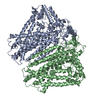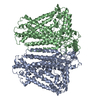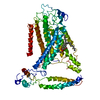+ Open data
Open data
- Basic information
Basic information
| Entry | Database: PDB / ID: 8grs | ||||||
|---|---|---|---|---|---|---|---|
| Title | human TMEM63A | ||||||
 Components Components | CSC1-like protein 1 | ||||||
 Keywords Keywords | MEMBRANE PROTEIN / channel | ||||||
| Function / homology |  Function and homology information Function and homology informationsurfactant secretion / osmolarity-sensing monoatomic cation channel activity / mechanosensitive monoatomic ion channel activity / calcium-activated cation channel activity / lysosome organization / tertiary granule membrane / specific granule membrane / centriolar satellite / early endosome membrane / nucleic acid binding ...surfactant secretion / osmolarity-sensing monoatomic cation channel activity / mechanosensitive monoatomic ion channel activity / calcium-activated cation channel activity / lysosome organization / tertiary granule membrane / specific granule membrane / centriolar satellite / early endosome membrane / nucleic acid binding / lysosomal membrane / intracellular membrane-bounded organelle / Neutrophil degranulation / extracellular exosome / plasma membrane Similarity search - Function | ||||||
| Biological species |  Homo sapiens (human) Homo sapiens (human) | ||||||
| Method | ELECTRON MICROSCOPY / single particle reconstruction / cryo EM / Resolution: 3.3 Å | ||||||
 Authors Authors | Zhang, M.F. | ||||||
| Funding support | 1items
| ||||||
 Citation Citation |  Journal: Nat Commun / Year: 2023 Journal: Nat Commun / Year: 2023Title: A mechanical-coupling mechanism in OSCA/TMEM63 channel mechanosensitivity. Authors: Mingfeng Zhang / Yuanyue Shan / Charles D Cox / Duanqing Pei /   Abstract: Mechanosensitive (MS) ion channels are a ubiquitous type of molecular force sensor sensing forces from the surrounding bilayer. The profound structural diversity in these channels suggests that the ...Mechanosensitive (MS) ion channels are a ubiquitous type of molecular force sensor sensing forces from the surrounding bilayer. The profound structural diversity in these channels suggests that the molecular mechanisms of force sensing follow unique structural blueprints. Here we determine the structures of plant and mammalian OSCA/TMEM63 proteins, allowing us to identify essential elements for mechanotransduction and propose roles for putative bound lipids in OSCA/TMEM63 mechanosensation. Briefly, the central cavity created by the dimer interface couples each subunit and modulates dimeric OSCA/TMEM63 channel mechanosensitivity through the modulating lipids while the cytosolic side of the pore is gated by a plug lipid that prevents the ion permeation. Our results suggest that the gating mechanism of OSCA/TMEM63 channels may combine structural aspects of the 'lipid-gated' mechanism of MscS and TRAAK channels and the calcium-induced gating mechanism of the TMEM16 family, which may provide insights into the structural rearrangements of TMEM16/TMC superfamilies. | ||||||
| History |
|
- Structure visualization
Structure visualization
| Structure viewer | Molecule:  Molmil Molmil Jmol/JSmol Jmol/JSmol |
|---|
- Downloads & links
Downloads & links
- Download
Download
| PDBx/mmCIF format |  8grs.cif.gz 8grs.cif.gz | 126.3 KB | Display |  PDBx/mmCIF format PDBx/mmCIF format |
|---|---|---|---|---|
| PDB format |  pdb8grs.ent.gz pdb8grs.ent.gz | 93.5 KB | Display |  PDB format PDB format |
| PDBx/mmJSON format |  8grs.json.gz 8grs.json.gz | Tree view |  PDBx/mmJSON format PDBx/mmJSON format | |
| Others |  Other downloads Other downloads |
-Validation report
| Summary document |  8grs_validation.pdf.gz 8grs_validation.pdf.gz | 1.4 MB | Display |  wwPDB validaton report wwPDB validaton report |
|---|---|---|---|---|
| Full document |  8grs_full_validation.pdf.gz 8grs_full_validation.pdf.gz | 1.4 MB | Display | |
| Data in XML |  8grs_validation.xml.gz 8grs_validation.xml.gz | 33.6 KB | Display | |
| Data in CIF |  8grs_validation.cif.gz 8grs_validation.cif.gz | 47.2 KB | Display | |
| Arichive directory |  https://data.pdbj.org/pub/pdb/validation_reports/gr/8grs https://data.pdbj.org/pub/pdb/validation_reports/gr/8grs ftp://data.pdbj.org/pub/pdb/validation_reports/gr/8grs ftp://data.pdbj.org/pub/pdb/validation_reports/gr/8grs | HTTPS FTP |
-Related structure data
| Related structure data |  34214MC  8grnC  8groC  8gsoC M: map data used to model this data C: citing same article ( |
|---|---|
| Similar structure data | Similarity search - Function & homology  F&H Search F&H Search |
- Links
Links
- Assembly
Assembly
| Deposited unit | 
|
|---|---|
| 1 |
|
- Components
Components
| #1: Protein | Mass: 92212.836 Da / Num. of mol.: 1 Source method: isolated from a genetically manipulated source Source: (gene. exp.)  Homo sapiens (human) / Gene: TMEM63A, KIAA0489, KIAA0792 / Production host: Homo sapiens (human) / Gene: TMEM63A, KIAA0489, KIAA0792 / Production host:  Homo sapiens (human) / References: UniProt: O94886 Homo sapiens (human) / References: UniProt: O94886 |
|---|---|
| #2: Chemical | ChemComp-POV / ( |
| Has ligand of interest | Y |
-Experimental details
-Experiment
| Experiment | Method: ELECTRON MICROSCOPY |
|---|---|
| EM experiment | Aggregation state: PARTICLE / 3D reconstruction method: single particle reconstruction |
- Sample preparation
Sample preparation
| Component | Name: human TMEM63A / Type: COMPLEX / Entity ID: #1 / Source: RECOMBINANT |
|---|---|
| Source (natural) | Organism:  Homo sapiens (human) Homo sapiens (human) |
| Source (recombinant) | Organism:  Homo sapiens (human) Homo sapiens (human) |
| Buffer solution | pH: 7.4 |
| Specimen | Embedding applied: NO / Shadowing applied: NO / Staining applied: NO / Vitrification applied: YES |
| Vitrification | Cryogen name: ETHANE |
- Electron microscopy imaging
Electron microscopy imaging
| Experimental equipment |  Model: Titan Krios / Image courtesy: FEI Company |
|---|---|
| Microscopy | Model: FEI TITAN KRIOS |
| Electron gun | Electron source:  FIELD EMISSION GUN / Accelerating voltage: 300 kV / Illumination mode: SPOT SCAN FIELD EMISSION GUN / Accelerating voltage: 300 kV / Illumination mode: SPOT SCAN |
| Electron lens | Mode: BRIGHT FIELD / Nominal defocus max: 3500 nm / Nominal defocus min: 2500 nm |
| Image recording | Electron dose: 60 e/Å2 / Film or detector model: GATAN K3 (6k x 4k) |
- Processing
Processing
| CTF correction | Type: NONE |
|---|---|
| 3D reconstruction | Resolution: 3.3 Å / Resolution method: FSC 0.143 CUT-OFF / Num. of particles: 155000 / Symmetry type: POINT |
 Movie
Movie Controller
Controller






 PDBj
PDBj

